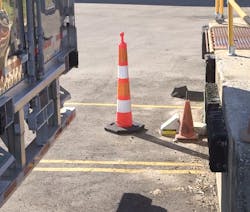HANNOVER, GERMANY. A transmission software update that can automate docking and remote diagnostics were among the advanced technologies showcased by Eaton’s Vehicle Group at the IAA 2016 commercial vehicle show. The company also put on display a new heavy-duty engine braking system that is integrated into the existing valve train and a waste heat recovery system now under development that it says could potentially improve diesel engine fuel efficiency by 20% while also reducing NOx.
Retrofitable to existing Eaton automated mechanical transmissions (AMTs) as a software update to the control module, Dock Assist automatically navigates the final few feet backing into a loading platform when activated by the driver via a switch. It requires no additional sensors, instead detecting the dock when torque increases as the vehicle touches the platform, according to Larry Bennett, chief engineer for the vehicle group. The system, which is currently being demonstrated with Eaton’s Procision medium-duty AMT, works with or without a trailer.
Development is also underway to extend automated docking to full maneuvering in a terminal and into an assigned dock without any driver intervention. Already in the prototype stage, this technology would allow a driver to leave their vehicle in a terminal where it would autonomously self-park, according to Bennett.
Both docking features are part of what Eaton is calling the Advanced Driver Assist System. Future development could extend it to platooning and autonomous stop-and-go in heavy traffic, he said.
Announced at IAA and available through Omnitracs telematics services, IntelliConnect Remote Diagnostics offers real-time monitoring of Eaton AMT fault code. It can also send diagnostic data through Navistar’s OnCommand portal or through a new dedicated Eaton portal, according to Bennett. It is seen as the first module in what Bennet says will be a suite of IntelliConnect products that could eventually even provide real-time remote control of vehicle shift management.
Building on variable valve timing technology it has developed for gasoline passenger car applications, Eaton also demonstrated a decompression brake for heavy-duty diesels that it says can provider higher braking performance at lower engine speeds. It can be integrated into a standard valve train assembly, allowing for reduced overall engine packaging while also reducing compression braking noise, according to Bennett.
Systems to recover engine waste heat are seen an potentially important components as engine manufacturers look for ways to meet the next phase of Federally maindated greenhouse gas (GHG) emissions reductions.
At IAA, Eaton showed one such system it has under development in conjunction with Paccar, Shell Oil and the U.S. Dept. of Energy. It combines supercharger rotors placed directly into the exhaust stream with devices that convert that energy into electric power. Not only could that power be used to run vehicle accessories, but it could also power an electrically assisted variable speed supercharger on the intake. Precise control of both intake and exhaust flows with such a system could reduce fuel consumption by up to 20% while also substantially reducing NOx emissions during engine start up, Bennett said.
About the Author
Jim Mele
Jim Mele is a former longtime editor-in-chief of FleetOwner. He joined the magazine in 1986 and served as chief editor from 1999 to 2017.
